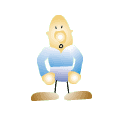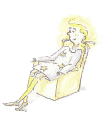Relaxation
Techniques -
Autogenic Training and Imagery
Autogenic Training
 Origin:
Origin:
In 1932, a German psychiatrist, Johannes Schultz has developed autogenic training from hypnosis. It retained the feeling of heaviness and warmth from hypnosis to autogenic training. Schultz hoped that autogenic training could dilate the blood vessels, increase blood circulation and body temperature, relax muscles and create a sense of heaviness so as to help people to deal with stressors effectively. At the beginning, autogenic training was used to treat neurotic patients. Eventually, it has been generalized to the people who want to regulate their psychological and physiological health.
Autogenic training is a method that uses imagery control and training in order to raise our sensitivity to our body parts. Then, it tries to regulate blood circulation and body temperature, relax muscles and extend the sense of relaxation to psyche.
 Posture
Posture
- Lie on your back with toes
leaning away from the body. Cushion any part of the body that feels
uncomfortable. Keep your arms lie alongside your body but not touch
it, with a slight bend at the elbows and the palms facing upward.

- Sit on a chair that can
support your head, and the seat is long enough to support your thighs.
Keep your buttocks against the back of the chair. Relax your arms, hands,
and fingers on the arms of the chair
 Sit
on a stool, upon which you sit without support for your back. Sit at
the forward part of the chair, put your arms on your thighs. Relax your
hands and fingers. Hang your head loosely with the chin near the chest.
Place your feet at the shoulder width.
Sit
on a stool, upon which you sit without support for your back. Sit at
the forward part of the chair, put your arms on your thighs. Relax your
hands and fingers. Hang your head loosely with the chin near the chest.
Place your feet at the shoulder width.
An example of autogenic relaxation is as follows:
- I am calm.
- It is quite.
- I am relaxed.
- My right arm (if right-handed) is very heavy. (Repeat four to five times)
- My right arm is warm. (Repeat four or five times)
- My right arm is tingly.
- My right arm is heavy and warm.
- My right arm is weighted down and feels warm.
- My left arm is very heavy. (Repeat four to five times)
- My left arm is warm. (Repeat four or five times)
- My left arm is tingly.
- My left arm is heavy and warm.
- My left arm is weighted down and feels warm. Both my arms are heavy and warm. (Repeat four or five times) (Repeat the phrases above for the legs, beginning with the dominant leg)
- My heart is beating calmly.
- I am relaxed.
- My heart is calm and relaxed. (Repeat four or five times)
- My breathing is regular.
- My breathing is calm.
- My breathing is calm and relaxed. (Repeat four or five times)
- It breathes me. (Repeat four or five times)
- My solar plexus is warm. (Repeat four or five times)
- I feel warmth throughout my abdomen. (Repeat four or five times)
- My forehead is cool. (Repeat four or five times) I am calm. I am relaxed. I am quiet.
 |
Imagery
Some autogenic training use relaxation imagery to extend the sense of relaxation to cognition. We have to imagine a relaxing scene and devote ourselves into it. This is called 'imagery'.
The steps of imagery are as follows:
| 1. | Now think of a relaxing scene. Imagine yourself there. See this scene clearly. Experience it. Be one with it. Hear the sounds. See the colors. This scene relaxes you. You are calm. You are quiet. You are at peace. Your mind is quiet. | |
| 2. | Your whole body is quiet, heavy, warm, and relaxed. Your thoughts are of your quiet, heavy, warm body and of your scene. Tell yourself you feel quiet, you feel relaxed, you feel calm. | |
| 3. |
Now prepare to leave the scene. Count backward from five. With each number you will be more alert. With each number you will be closer to opening your eyes. (4) You are back in this room. You are seated (or reclined). You know where you are. (3) Prepare to open your eyes. Think of what you will see when you open your eyes. (2) Open your eyes. Focus upon one object in the room. Take a deep breath. (1) Focus on objects about the room. Take several deep breaths. |
|
| 4. | When you feel ready, stretch your arms and legs. Now stand and stretch.Take several more deep breaths. | |
| 5. | Now proceed with your regular activities knowing that you are refreshed and revitalized. | |
Benefits of Autogenic Training and Imagery:
- Physiological aspects: It can reduce heart rate, breathing rate, muscle tension, and increase brain waves, the flow of blood to arms and legs, and treat migrate headache, insomnia, hypertension, indigestion, ulcers, bronchial asthma, tuberculosis, diabetes and backache.
- Psychological aspects: It can reduce anxiety, tiredness, depression, and increase the ability to deal with stressors.
Pre-requisites:
- Maintenance of high motivation.
- Employment of self-direction and self-control.
- Maintenance of particular body posture, e.g. lie on our back, or sit on a straight-backed chair.
- Reduction of external stimuli.
- Focus on inward consciousness.
- Giving up ego boundaries.
Reference: Jerrold . S Greenberg (1999) . "Comprehensive stress managment" sixth edition p. 157